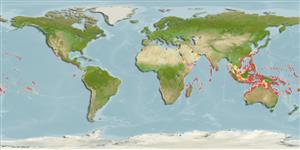Actinopterygii (ray-finned fishes) >
Perciformes (Perch-likes) >
Pomacanthidae (Angelfishes)
Etymology: Pomacanthus: Greek, poma, -atos = cover, operculum + Greek, akantha = thorn (Ref. 45335).
Environment / Climate / Range
Ecology
Marine; reef-associated; non-migratory; depth range 1 - 40 m (Ref. 90102). Tropical, preferred ?; 30°N - 30°S
Indo-West Pacific: Red Sea and East Africa to Samoa, north to southern Japan, south to Western Australia and New South Wales, including Lord Howe Island (Ref. 1602).
Size / Weight / Age
Maturity: Lm ? range ? - ? cm
Max length : 40.0 cm SL male/unsexed; (Ref. 30573)
Juveniles inhabit shallow protected areas, while adults prefer coastal reefs with heavy coral growth providing ample hiding places. Generally solitary or in pairs. Feeds on sponges, tunicates, and algae (Ref. 30573). The young are excellent aquarium fish and suitable for a community tank.
Life cycle and mating behavior
Maturity | Reproduction | Spawning | Eggs | Fecundity | Larvae
Myers, R.F., 1991. Micronesian reef fishes. Second Ed. Coral Graphics, Barrigada, Guam. 298 p. (Ref. 1602)
IUCN Red List Status (Ref. 115185)
CITES (Ref. 94142)
Not Evaluated
Threat to humans
Harmless
Human uses
Fisheries: minor commercial; aquarium: commercial
More information
Common namesSynonymsMetabolismPredatorsEcotoxicologyReproductionMaturitySpawningFecundityEggsEgg development
Tools
Special reports
Download XML
Internet sources
Estimates of some properties based on models
Phylogenetic diversity index (Ref.
82805): PD
50 = 0.5001 [Uniqueness, from 0.5 = low to 2.0 = high].
Trophic Level (Ref.
69278): 2.7 ±0.00 se; Based on food items.
Resilience (Ref.
69278): Medium, minimum population doubling time 1.4 - 4.4 years (Preliminary K or Fecundity.).
Vulnerability (Ref.
59153): Moderate to high vulnerability (50 of 100) .
